
New York Times story on the acquisition of Newsweek by the Washington Post, March 10, 1961.

Phil Graham & Eugene Meyer holding 1st copy of the newly merged Washington Post-Times Herald, amid St. Pat’s celebration, 17 March 1954.

Phil Graham, rising newspaper man, on Time cover, 1956.
The Newsweek Story
Newsweek, originally launched under the name News-Week in February 1933, was founded with the help of a group of wealthy stockholders that included Ward Cheney, of the Cheney silk family; John Hay Whitney, owner of the New York Herald Tribune; and Paul Mellon, of the industrial and banking Mellons. Other industrialists, investment bankers, and corporate lawyers were also added to the magazine’s stockholders in later years. News-Week’s first issue in 1933 featured seven photographs from the week’s news on its cover. By 1937, it merged with another weekly journal named Today, founded several years earlier by former New York Governor and diplomat Averell Harriman and Vincent Astor of the prominent Astor family. Vincent Astor became News-Week’s chairman and its principal stockholder. Malcolm Muir took charge as editor-in-chief and President, changing the news magazine’s name to Newsweek, abolishing the hyphen.
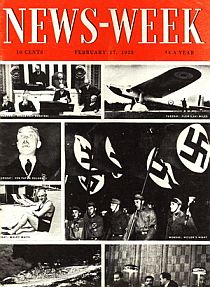
1st edition of News-Week, 17 Feb 1933, featuring its '7-photos-of-the-week' format, later abandoned as confusing to readers.
Genesis of a Deal
Meanwhile, a group of Newsweek’s journalists in its Washington and New York bureaus were concerned about the fate their magazine. They worried that it might fall into the wrong hands. Among those concerned was Ben Bradlee, Newsweek’s bureau chief in Washington. Bradlee had hoped that one of the major newspaper families might be persuaded to buy Newsweek — publishers “who ran newspapers of conscience and quality,” as he put it; publishers such as Joe Pulitzer of the St. Louis Post- Dispatch, Marshall Field of the Chicago Sun Times, or Phil Graham at The Washington Post. Bradlee, in fact, had once worked for Graham at the Post but knew him only slightly. Yet as Newsweek was then heading for an uncertain fate, Bradlee would initiate a meeting with Phil Graham, urging him to buy Newsweek. Writing in his 1995 book, A Good Life, Bradlee recalls the meeting he had with Graham:
. . .One night, after a bad day of brooding, and a few shooters, I called [Osborn] Elliott in New York [Newsweek’s managing editor] and told him I was damn well going to pick up the phone — it was almost 11:00 p.m. — and call Phil Graham right then. Ben Bradlee, then chief of Newsweek’s Washington bureau, became a player in the Washington Post / Newsweek deal.It was the best telephone call I ever made — the luckiest, most productive, most exciting, most rewarding, totally rewarding. He answered the phone himself. I blurted out that I wanted to talk to him soonest about the Post buying Newsweek. He said simply, “Why don’t you come on over? Now.”
I was sitting in his living room ten minutes later. I stayed there talking, and trying to answer his questions — mostly about people, who was good and who was bad and why — until just before 5:00 a.m. I was back at 9:00 a.m., as ordered, with fifty pages of thoughts, “just stream-of-consciousness stuff. . . No one’s going to read it but me,” Graham told me. I scarcely knew Phil Graham. . . .
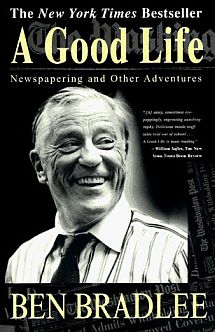
Ben Bradlee writes about the Newsweek deal, among other things, in his 1995 memoir.
Essentially my pitch to him was that Newsweek could be made into something really important by the right owner, if only the right people were freed to practice the kind of journalism Graham knew all about; that Newsweek was about to be sold to someone (whomever) who wouldn’t understand or appreciate its potential; that it wouldn’t require a lot more money. . . maybe a few thousand bucks worth of severance pay, and maybe Newsweek was just the right property for The Washington Post to make a move toward national and international stature. He got my message long before I was through delivering it, and all he wanted to talk about was the cast of characters [at Newsweek]. Who was who — in the Washington Bureau and in New York, on the news side and on the business side. God knows what I said, I was so turned on by his interest and enthusiasm. Luckily, there is no written record of this conversation, and the fifty-page memo I gave him at nine that morning has mercifully disappeared. I’m sure I was indiscreet; he encouraged indiscretion with indiscretion, and before I left he was using ‘we’ and saying ‘could.’
Bradlee thereafter became part of Graham’s inner group of advisers on the deal, and traveled to New York with Graham as the deal unfolded. Among others bidders for Newsweek was the magazine’s then Chairman Malcolm Muir, 75, who hoped to enlarge his family’s 13 percent holding in the magazine with the Astor shares. But after Phil Graham heard that bidding for the foundation stock had held around $45 a share, he raised his bid to $50, which was then about 24 times the magazine’s earnings per share. Some back home at the Post worried about the amount of money involved, and thought it could better spent to improve the Post’s operations and quality. “Though the official selling price for Newsweek was $15 million, in the end no more than $75,000 really changed hands. It was one of the great steals of contemporary journal- ism.” –David Halberstam And in addition to the bidding for Newsweek by Muir, others with considerable resources were also involved, including Doubleday, the book publisher, and Sam Newhouse, the newspaper mogul. But in the end, Graham’s offer of $50 a share proved the winning bid as the Post took the prize.
It turned out that the Post had struck a very good bargain. At $50 a share, the total price for the deal appeared to be something like $15 million. But Newsweek had $3 million in cash in the bank, and owned half interest in a San Diego TV station, which the Post later sold for $3 million. In the end, the real price for the acquisition was closer to $9 million, with Prudential Insurance Co., one of the backers, carrying most of that. In addition, Newsweek’s books looked very promising for the road ahead, as the magazine had average $15 million a year in profit for the last thirty years. “Though the official selling price for Newsweek was $15 million, in the end no more than $75,000 really changed hands,” wrote David Halberstam in his book The Powers That Be. “It was one of the great steals of contemporary journalism.”
Newsweek in Nov 1960, prior to the Washington Post acquisition.
Phil Graham, meanwhile, went on to expand the reach and influence of the Washington Post Co. and its assorted enterprises. In 1962, Graham helped establish a 50/50 Washington Post-Los Angeles Times news service formed to broaden and syndicate the reach of both papers. The service soon boasted a strong Washington bureau as well as global coverage with a range of notable writers. Graham also went looking for additional writing talent, and in October 1962 he signed up New York Herald Tribune columnist Walter Lippmann, who would also write columns for Newsweek and the new wire service. A month later, he added another well-known writer, Joe Alsop. The news service by then had signed up 33 U.S. dailies with the British papers, the London Sunday Times, Manchester Guardian, and London Observer coming on later. Back at the Washington Post, Graham had raised salaries, increased circulation, and beat rival Washington Star in advertising. But Phil Graham was in trouble.
Loss of Phil Graham
Graham, for some years, had been an undiagnosed and untreated manic-depressive, and in the early 1960s, his condition worsened. In August 1963, he took his own life. The event devastated the Post and was seen as a major loss. Sam Newhouse offered Katharine Graham $100 million for Newsweek, but she wasn’t selling. Gradually, following Phil Graham’s passing, his wife and Eugene Meyer’s daughter, Katharine, also known as Kay by colleagues, assumed the mantle at The Washington Post, including Newsweek. Two years after her husband’s death, in 1965, Sam Newhouse offered Katharine Graham $100 million for Newsweek, a substantial premium over what Phil Graham had paid of it. But Katharine Graham wasn’t interested in selling. She was interested in growing her company. Along the way, she pumped more money into Newsweek, eventually making it a more robust player in the weekly competition with Time and U.S. News & World Report.
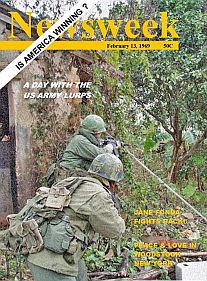 Vietnam War story, 13 Feb 1969. |
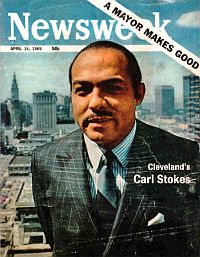 Cleveland's first black mayor featured, April 14, 1969. |
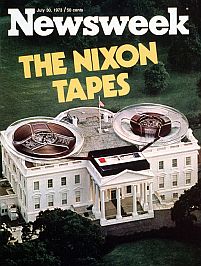 30 July 1973 edition, after the Post had broken Watergate story. |
During the 1960s, Newsweek distinguished itself from Time by appealing to younger readers and focusing on two big stories of the era: race relations and the Vietnam War. In July of 1963, Newsweek had already been the first major news magazine to put the face of an unknown black American on its cover. But in November of 1967, the magazine ran a civil rights cover story and editorial. Newsweek‘s then-editor Osborn Elliott, would later say the cover story questioned traditional notions of journalistic “objectivity,” calling it the first example advocacy journalism by any major magazine.” In 1968, following the Tet Offensive in Vietnam, Newsweek again offered its views, this time calling for de-escalation of the war and eventual U.S. withdrawal.
Back at the Washington Post, Kay Graham was also focusing on her newspaper. In August 1965, she lured Ben Bradlee away from his Newsweek bureau chief post to become a deputy managing editor at the Post, with promises of bigger things to come. By 1968, Bradlee became executive editor with Kay Graham’s backingNewsweek became a leader in advocacy journalism.. He initiated change at the paper early on, including the January 1969 creation of a culturally and politically attuned “Style” section, replacing a dated “For and About Women” section. Bradlee and Graham would proceed to lead the paper into the thicket of some of the next decade’s most important issues, publishing the Pentagon Papers in 1971 — a secret history of the Vietnam War — and winning a Pulitzer prize for the paper with its 1972-73 coverage of the Watergate scandal that led to the resignation of President Richard Nixon. The Post’s coverage of these and other issues would also show through to some extent in Newsweek’s coverage.
Recent History
The Washington Post continued to publish Newsweek through the 2000s. However, by 2008 Newsweek was losing money – $16 million that year, followed by $29 million loss in 2009, and heading for another $20 million-plus loss in 2010. Advertising had been down 30 percent in 2009 and 40 percent in the first three months of 2010.
Then there was the euphemistically described “generational change in reading patterns,” meaning the digital tsunami that was ravaging traditional print newspapers and magazines.
In May 2010, after 49 years of Newsweek ownership, the Washington Post put the magazine up for sale.
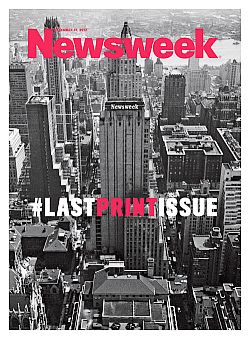
December 2012: Last print issue of Newsweek.
Tina Brown, a well-traveled editor who had notable stints at Vanity Fair and The New Yorker, became editor of the merged Newsweek-Daily Beast entity. The venture undertook some interesting initiatives, but had rocky going as it went through changes. In October 2012, Brown announced that Newsweek would cease print publication with the December 31, 2012, issue and transition to an all-digital format, to be called Newsweek Global.
On August 3, 2013, IBT Media, a global digital news organization based in New York, announced it had acquired Newsweek from IAC on terms that were not disclosed. The acquisition included the Newsweek brand and its online publication, but not The Daily Beast.
The Washington Post, meanwhile, was having it own financial difficulties, as the Graham-family owned and run newspaper was bleeding pretty badly with successive years of losses.
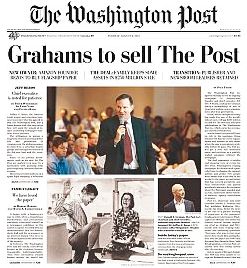
August 2013: Washington Post sold to Jeff Bezos.
For other stories on publishing history at this website see the “Print & Publishing” category page. A Warren Buffett story at this website also includes some history on Kay Graham and the Post’s relationship with Buffett during the 1970s and 1980s. Thanks for visiting – and if you like what you find here, please make a donation to help support this website. Thank you. – Jack Doyle
|
Please Support Thank You |
_____________________
Date Posted: 8 April 2008
Last Update: 4 September 2019
Comments to:jdoyle@pophistorydig.com
Article Citation:
Jack Doyle, “Newsweek Sold!, 1961,”
PopHistoryDig.com, April 8, 2008.
_______________________
Sources, Links & Additional Information
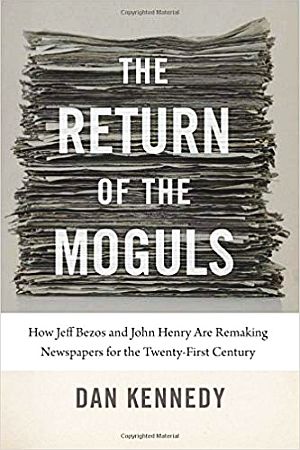
Dan Kennedy’s 2018 book, “The Return of the Moguls: How Jeff Bezos and John Henry Are Remaking Newspapers for the Twenty-First Century.” Click for copy.
“Newsweek’s News,” Time, Friday, March 17, 1961.
“More Fanciful Than Real,” Time, Friday, October 12, 1962.
“A Discontented Man,” Time, Friday, August 9, 1963.
David Halberstam, The Powers That Be, New York: Alfred A. Knopf, 1979, p. 364.
Amy Janello and Brennon Jones. The American Magazine. New York, Harry N. Abrams, Inc: 1991.
John Tebbel, and Mary Ellen Zuckerman. The Magazine in America: 1741-1990. New York, Oxford University Press: 1991.
Ben Bradlee, A Good Life: Newspapering and Other Adventures, New York: Simon & Schuster, 1995, pp. 223-253.
David E. Sumner, “A History of Time, Newsweek, and U.S. News & World Report,” Encyclopedia of International Media and Communication, 2003, Academic Press: Ball State University, November 5, 2005.
“Washington Post Group: Overview,” Ketupa.net, November 5, 2005.
Mel Gussow, “Newsweek Alumni: Nostalgia and History,” New York Times, March 1, 2004.
Newsweek, History & Background, MagsDirect.com.
“Business Properties-Newsweek,” Washington Post Company.